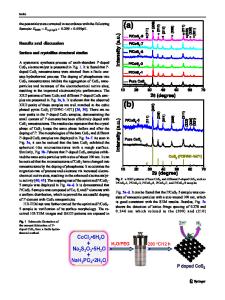Electrospinning CoS 2 /carbon nanofibers with enhanced stability as electrode materials for supercapacitors
- PDF / 4,867,581 Bytes
- 10 Pages / 595.276 x 790.866 pts Page_size
- 2 Downloads / 364 Views
ORIGINAL PAPER
Electrospinning CoS2/carbon nanofibers with enhanced stability as electrode materials for supercapacitors Zhao Wang 1 & Chao Liu 1 & Gaofeng Shi 1 & Guoying Wang 1 & Qi Zhang 1 & Hongquan Zhang 1 & Ying Su 1 & Jianglei Yu 1 & Xin Li 1 & Fengfang Luo 1 & Yawen Hu 1 & Kaiqiang Yi 1 Received: 8 June 2020 / Revised: 13 July 2020 / Accepted: 27 July 2020 # Springer-Verlag GmbH Germany, part of Springer Nature 2020
Abstract The performance of supercapacitors is strongly influenced by the performance of electrode materials. The cobalt-sulfur compounds are used as electrode materials due to their wide range of sources, low price, and high conductivity. It was found that higher number of electron-hole pairs and higher conductivity could be provided by sulfidation. This is related to the mixing valence of Co in the cobalt sulfur compound, which promotes electron transfer to the electrolyte. During the charging and discharging process, CoS2 is not easy to fall off from the surface of carbon nanofibers, thus increasing the doubling rate and cycling stability, due to the one-dimensional morphology of the interconnected conductive paths and excellent mechanical stability. At the current density of 1 A g−1, the specific capacitance of CoS2-CNFs reaches 488.0 F g−1, over 74% of initial capacitance is retained as the current density improves from 1 to 10 A g−1, and it also exhibits an excellent cycling performance with 91.0% capacitance retention after 1000 times charge/discharge cycles (at the current density of 1 A g−1). Keywords Electrospinning . CoS2-CNFs . Supercapacitors . Electrochemical performance
Introduction With the rapid development of economy, people’s demand for energy is increasing. That has led researchers around the world to pay more attention to research on energy storage. As a novel energy storage device, supercapacitors have attracted more and more attention due to its unique advantages: short charging time, high power density, and excellent cycle stability [1, 2]. Therefore, it is expected to be used in electric vehicles, portable tools, and other fields [3]. As one of the main factors affecting the performance of supercapacitors, electrode material has many kinds [4]. As the earliest electrode material used for supercapacitors, carbon materials have advantages of wide sources, low cost, easy operation, and no toxicity [5]. Carbon material has abundant pore structure, which shows good electrochemical performance [6, 7]. As the electrode material, carbon materials have high
* Gaofeng Shi [email protected] 1
School of Petrochemical Engineering, Lanzhou University of Technology, Lanzhou city, China
conductivity, stability, and high power density, and their theoretical specific capacity are insufficient, and the voltage window in the water electrolyte is narrow, resulting in low energy density, which cannot meet the needs of the current special field, thus limiting the application in supercapacitors [8, 9]. Due to their unique physicochemical properties, the transition metal compounds hav
Data Loading...











